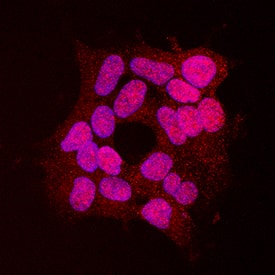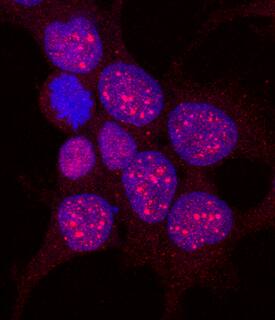SUMO3 Products
Human Small Ubiquitin-like Modifier 3 (SUMO3), also known as SMT3A, is synthesized as a 103 amino acid (aa), propeptide with a predicted 11.5 kDa. SUMO3 contains a two aa C-terminal prosegment. Human SUMO3 shares 83% sequence identity with mouse SUMO3. SUMO3 also has high aa sequence homology to SUMO2 and SUMO4, 87% and 75%, respectively. SUMO3 shares only 47% sequence identity with SUMO1. SUMOs are a family of small, related proteins that can be enzymatically attached to a target protein by a post-translational modification process termed SUMOylation. All SUMO proteins share a conserved Ubiquitin domain and a C-terminal diglycine cleavage/attachment site. Following prosegment cleavage, the C-terminal glycine residue of SUMO3 is enzymatically attached to a lysine residue on a target protein. In humans, SUMO3 is conjugated to a variety of molecules in the presence of the SAE1/UBA2 SUMO-activating (E1) enzyme and the UBE2I/Ubc9 SUMO-conjugating (E2) enzyme. In yeast, the SUMO-activating (E1) enzyme is Aos1/Uba2p. Because of the high level of sequence homology most studies report effects of SUMO2/3. For example, addition of SUMO2/3 was shown to modulate the function of ARHGAP21, a RhoGAP protein known to be involved in cell migration. Other reports indicate that the conjugation by SUMO2/3, but not SUMO1, may represent an important mechanism to protect neurons during episodes of cerebral ischemia. However, studies suggest that SUMO2/3 expression is regulated in an isoform-specific manner since oxidative stress downregulated the transcription of SUMO3 but not SUMO2.
5 results for "SUMO3" in Products
5 results for "SUMO3" in Products
SUMO3 Products
Human Small Ubiquitin-like Modifier 3 (SUMO3), also known as SMT3A, is synthesized as a 103 amino acid (aa), propeptide with a predicted 11.5 kDa. SUMO3 contains a two aa C-terminal prosegment. Human SUMO3 shares 83% sequence identity with mouse SUMO3. SUMO3 also has high aa sequence homology to SUMO2 and SUMO4, 87% and 75%, respectively. SUMO3 shares only 47% sequence identity with SUMO1. SUMOs are a family of small, related proteins that can be enzymatically attached to a target protein by a post-translational modification process termed SUMOylation. All SUMO proteins share a conserved Ubiquitin domain and a C-terminal diglycine cleavage/attachment site. Following prosegment cleavage, the C-terminal glycine residue of SUMO3 is enzymatically attached to a lysine residue on a target protein. In humans, SUMO3 is conjugated to a variety of molecules in the presence of the SAE1/UBA2 SUMO-activating (E1) enzyme and the UBE2I/Ubc9 SUMO-conjugating (E2) enzyme. In yeast, the SUMO-activating (E1) enzyme is Aos1/Uba2p. Because of the high level of sequence homology most studies report effects of SUMO2/3. For example, addition of SUMO2/3 was shown to modulate the function of ARHGAP21, a RhoGAP protein known to be involved in cell migration. Other reports indicate that the conjugation by SUMO2/3, but not SUMO1, may represent an important mechanism to protect neurons during episodes of cerebral ischemia. However, studies suggest that SUMO2/3 expression is regulated in an isoform-specific manner since oxidative stress downregulated the transcription of SUMO3 but not SUMO2.
| Reactivity: | Human |
| Details: | Rat IgG2a Monoclonal Clone #401513 |
| Applications: | ICC |
Recombinant Monoclonal Antibody.
| Reactivity: | Human |
| Details: | Rat IgG2a Monoclonal Clone #401513R |
| Applications: | ICC |
| Reactivity: | Human, Mouse |
| Details: | Goat IgG Polyclonal |
| Applications: | WB |
| Applications: | WB |
| Reactivity: | Human, Mouse |
| Details: | Goat IgG Polyclonal |
| Applications: | WB |





![Western Blot: SUMO3 Overexpression Lysate [NBL1-16613] Western Blot: SUMO3 Overexpression Lysate [NBL1-16613]](https://resources.bio-techne.com/images/products/Sumo-3-Overexpression-Lysate-Adult-Normal-Western-Blot-NBL1-16613-img0002.jpg)
